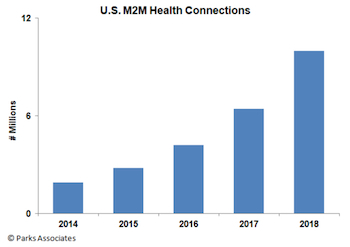 More than 40 million US smartphone owners are active users of at least one wellness or fitness app, according to research firm Parks Associates. The firm has also reported that one in four heads of household -- at homes with broadband -- use a mobile app to track their fitness or track their caloric intake.
More than 40 million US smartphone owners are active users of at least one wellness or fitness app, according to research firm Parks Associates. The firm has also reported that one in four heads of household -- at homes with broadband -- use a mobile app to track their fitness or track their caloric intake.
Last year the research firm published research that estimated 41 percent of caregivers in broadband homes used some kind of digital health device.
Interestingly, Parks recommends that mobile operators in the US become more active in offering digital health services to businesses and consumers. The firm specifically suggests text messaging-based health, weight management, and prescription authentication programs as potential revenue streams for mobile operators.
“Digital health is an important part of the Internet of Everything, and wireless carriers need to align their connected health businesses with their larger connected living strategies,” Jennifer Kent, Director, Research Quality and Innovation, at Parks Associates said in a statement. “Mobile carriers have multiple opportunities to provide value for business customers and consumers, though the landscape differs significantly by region.”
US mobile operators have developed digital health products and partnered with a handful of companies in the space to offer health services, but most of those efforts have since been shutdown. Years ago AT&T partnered with WellDoc for an early version of its diabetes management program, but the two have since gone their separate ways. Just last year Verizon shuttered its digital health products -- a video visits offerings and an FDA-cleared piece of software that acted as a home health hub for various connected devices.
AT&T, Verizon, and most other US carriers, however, continue to offer a variety of services to healthcare companies.
“U.S. mobile carriers are focused on providing enterprise services, like cloud storage and teleconferencing solutions, to their healthcare provider clients,” Kent said. “However, carriers can play a valuable role in the consumer space. Given their established relationships with consumers, expertise in providing consumer-facing services, and connection to consumers’ mobile devices, carriers can bridge the divide between care providers and consumers, particularly in regards to health data collection and transfer as well as communications between providers and patients.”
Parks also shared that connected health devices made up about 4 percent of all machine-to-machine (M2M) connections last year, and the healthcare segment will double over the course of the next five years, the firm predicts.

















